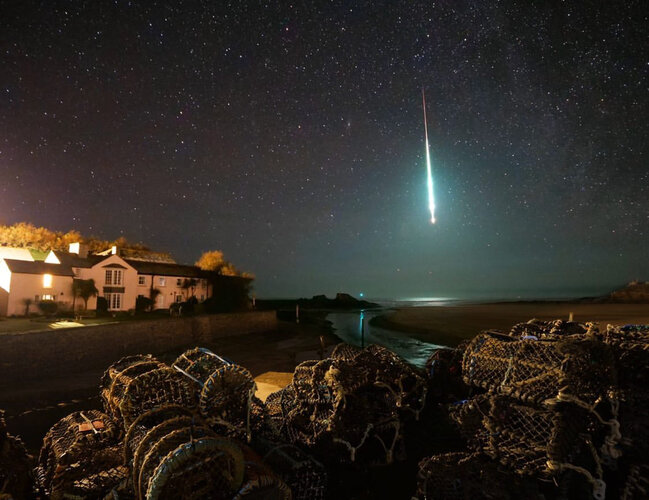
Image:
On 21 January, a foreign body crashed to Earth causing a cascade of bright light to trail through the sky.
The fleeting flash was a fireball, defined as a meteor brighter than the planet Venus. Such bright meteors are caused as small asteroids strike the atmosphere, entirely or almost entirely burning up due to friction, sometimes suddenly exploding.
Every day, roughly 54 tonnes of extra-terrestrial material reaches Earth, including interplanetary dust, meteoroids and asteroids. Fireballs like this one are estimated to strike Earth hundreds of times every year, however not all are caught on camera or shine so brightly.
From the brightness of this fireball, around the time of a full moon, experts have deduced that the original object could have ranged from tens of centimetres to a metre in size, depending on its entry speed, composition and other characteristics.
This impressive shot was captured by photographer Chris Small at the seaside resort town of Bude, northeast Cornwall, England, at 23:24 UTC.
“I see a lot of meteors due to spending so long shooting the night sky, but I’ve never seen anything quite like that before!” says Chris.
“It was incredible, and lit up the entire coast almost as bright as daytime for a few seconds. There were beautiful green and blue colours.”
While the foreground is filled with lobster pots used by local fishermen, the background is lit up with this green-blue tinge, revealing the presence of oxygen in Earth’s atmosphere. As the air surrounding the burning ball heats up, atoms become ‘excited’, with oxygen emitting light at a frequency of about 558 nm – in the blue-green part of the visible spectrum.
This colourful effect is also the reason for the beautiful aurorae at Earth’s poles, caused as charged particles from the Sun strike and excite atoms in the upper atmosphere.
The fireball in this image was spotted by at least five observers across the UK, who reported it to the International Meteor Organization – an organisation set up to collect meteor observations from around the world.
A new ESA warning system called NEMO (NEar-real time MOnitor) also picked up the event shortly after it happened. The NEMO system tracks social media activity to build a near real-time picture of fireball events around the globe, and is part of the Agency’s Planetary Defence Office.
Find more of Chris’ photography on his website, Ocean And Earth Photography.
Click here for original story, Cosmic caller goes out with a bang
Source: ESA Space News